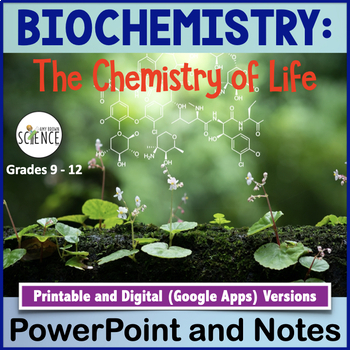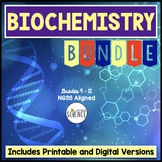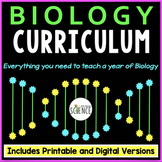Biochemistry Macromolecules Organic Compounds Powerpoint and Notes
- Zip
- Google Apps™

What educators are saying
Also included in
- This complete teaching unit on "Biochemistry: The Chemistry of Life" includes everything you need to teach this unit to your life science or biology students. Many of the resources are available in BOTH printable and digital formats. Resources include an 88-Slide Powerpoint presentation packed witPrice $45.99Original Price $60.45Save $14.46
- This NO PREP, PRINTABLE, EDITABLE, AND DIGITAL Biology Curriculum contains everything you need for an entire year of Biology! For less than $3 a day, you can save your time, energy, and sanity. Each of the 20 Complete Units includes a teaching PowerPoint presentation, notes, labs, homework assignmenPrice $525.00Original Price $988.18Save $463.18
Description
These 88 slides will captivate your students with stunning photos and diagrams to provide an in-depth study of "The Chemistry of Life" for your biology students. Choose to use the traditional printable version, or the paperless, digital Google Apps version. The PowerPoint covers all the topics you would expect to find in a traditional high school biology textbook, including the nature of matter, chemical bonds, the properties of water, carbon compounds, the macromolecules, and so much more. Please see the detailed list of topics below.
What is included in this resource?
- An 88-Slide PowerPoint Presentation (Includes traditional PowerPoint, PDF, and Google slides)
- Editable and printable 15-page set of lecture notes for the teacher
- Editable and printable 18-page guided notes outline for the student
- Paperless Digital Version (not editable) for use in Google Drive, Google Classroom, and /or Microsoft OneDrive
- Teacher Guide for google Apps
The Power Point is designed to hold the attention of your students. The 88 slides are bright and colorful and contain loads and loads of visually appealing pictures and images. Animations and transitions are included to allow you to control the pace of the lesson.
Your students are going to love using the outline as you teach. It allows the student more freedom to listen, think, and ask questions during note-taking. The notes are also perfect for students with disabilities or IEP's.
The topics covered include the following:
- The Nature of Matter: Atoms, subatomic particles, mass and charges of the subatomic particles.
- Elements: Definitions, isotopes, radioactive isotopes, practical uses of radioactive isotopes, the nature of compounds.
- Chemical Bonds: Definitions and examples of ionic and covalent bonds, polar molecules, polar covalent bonds, nonpolar covalent bonds.
- Properties of Water: The polarity of water molecules, hydrogen bonding, hydrogen bonds in ice, liquid water, and water vapor, cohesion and adhesion.
- Mixtures, Solutions, and Suspensions: Definitions, homogeneous and heterogenous solutions, solute, solvent.
- Reasons why water makes life possible.
- Acids, Bases, and pH: The pH scale, definitions of acids and bases, buffers, why buffers are essential to the life of a cell.
- Carbon Compounds: The difference between organic and inorganic compounds, the characteristics of carbon that allow for the building of a large variety of biological molecules.
- Functional Groups: Definition of functional group and their role in chemical reactions. Four common functional groups are covered: Hydroxyl, carboxyl, amino, and phosphate groups.
- Macromolecules; Definition of macromolecule, groups of macromolecules, polymerization, monomers, polymers, condensation reactions, hydrolysis reactions
- Carbohydrates: Examples of carbohydrates, characteristics of carbohydrates, building blocks or monomers of carbohydrates, functions of carbohydrates in cells, monosaccharides, disaccharides, polysaccharides, starch, glycogen, cellulose.
- Lipids: Examples of lipids, characteristics of lipids, building blocks or monomers of lipids, nonpolar nature of lipids, fatty acids, glycerol, saturated and unsaturated fats, triglycerides, phospholipids, waxes.
- Proteins: Examples of proteins, characteristics of proteins, building blocks or monomers of proteins, the structure of amino acids, dipeptides, polypeptides, the relationship between shape and function of proteins.
- Enzymes: Definitions and the role of enzymes in cells, equation for how an enzyme works, substrate molecules, active site, products.
- Nucleic Acids: Brief introduction to nucleic acids, two type of nucleic acids, building blocks of nucleic acids.
This PowerPoint and Notes set is so complete and comprehensive it can be used in place of a textbook. If you are already using a textbook you love, the PowerPoint and notes are editable and are easily incorporated into your existing lessons and units.
Related Resources Include the Following:
Lab: Testing for Organic Compounds in Foods
Macromolecules Color by Number Activity
Biochemistry Google Sheets Hidden Picture Reveal Activities - 4 Game Set
Biology Buzz Words: Biochemistry and The Chemistry of Life
FREE Enzyme Catalase Lab Activity
Enzymes Color By Number Activity
Properties of Water Color by Number
Organic Compounds Homework or Quiz
Organic Compounds Mix/Match Game
Lab: The Release of Heat in an Enzymatic Reaction
Biochemistry Homework Assignment and Study Guide Worksheets
Organic Compounds Graphic Organizer
Biochemistry quizzes--Set of 2
Biochemistry Jeopardy Review Games - Set of 2
Test: The Chemistry of Life (Biochemistry)
For updates about sales and new products, please follow my store:







